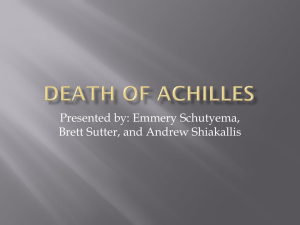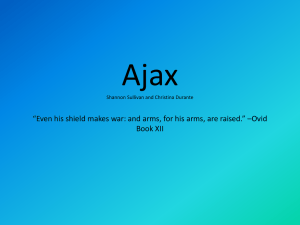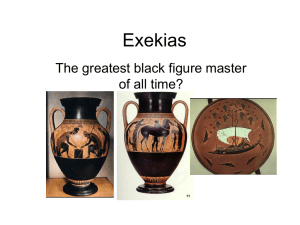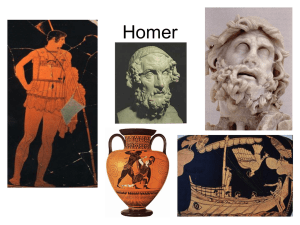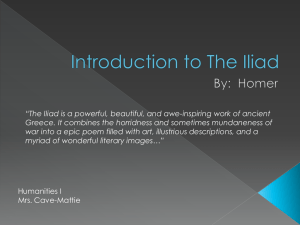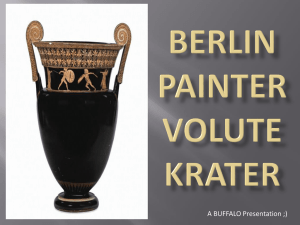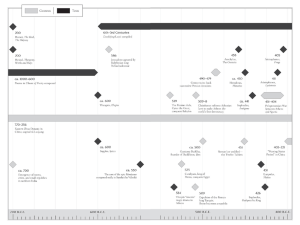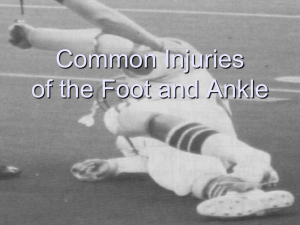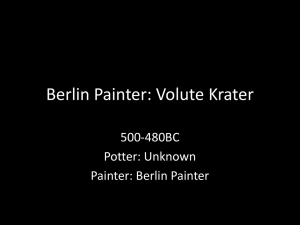Exekias Belly Amphora Powerpoint
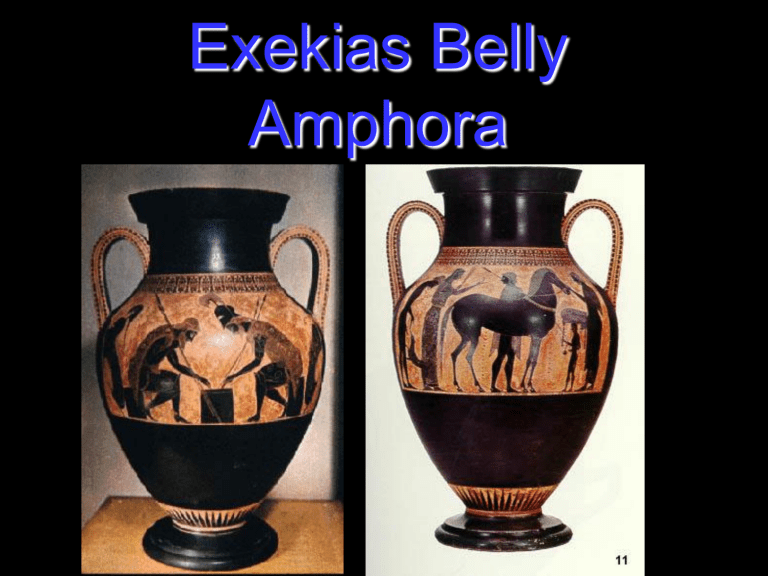
Exekias Belly
Amphora
Exekias
- Ancient Greek vase painter and potter.
- Worked approx. between 550BC – 525BC.
Mainly worked with technique known as ‘black figure’.
- Considered to be one of the best black figure vase painters .
- Master of psychological tension .
Belly Amphora
Side A
Achilles + Ajax
Side B
Return of Diskouri
Attribution Detail
Name: Exekias Belly Amphora
Date: 550 - 540 B.C.
Height: 61cm
Potter & Painter: by Exekias
How is the painter identified?
He signed his name onto the vase, on the rim of the vase.
Translates to “Exekias made me”
The Shape
1. Amphora
2. Used for storage of wine, honey/ oil
3. Larger neck, broader shoulder, flanged decorated handle.
4. Made and painted the vase.
5. Base of neck – Vases mid-point
7. Chain of ivy leaves
*The Shape
• Continuous line from foot to mouth
• Foot is stepped.
(Foot is moulded in two parts, so it looks like steps.)
Inscriptions
1. Exekias painted and made me
2. Achilles and Ajax
3. Three (Ajax)
4. Four (Achilles)
*Where its found
1. Found on the rim of the vase and also on the left behind
Achilles.
2. On top-behind their heads
3.&4. Coming out of their mouths
(Other inscription)
There is a kalos inscription, it reads: “Onetorides is beautiful)
*Story behind Side A
• A scene from a lost poem about the
Trojan War. Achilles and Ajax are involved playing a board game. They are unaware that the enemy is approaching, and they are still playing when the Trojans attack their camp. Any Greek who saw this would have known what it was about and what was about to happen.
.
The Scene
5- Achilles & Ajax (best friend)
6Achilles’ name is inscribed next to him and so is Ajax’s’ name
.
7- Achilles and Ajax are involved playing a board game.
Unaware that the enemies are approaching they are still playing when the Trojans attack their camp.
8He doesn’t show what’s happening in the moment. Here, he’s shown what’s happening before the battle, and in the
8-
Kylix he showed what happened after the pirates attacked Dionysus.
• Queen Leda – Her peplos is flat and fold less.
• Slave Boy – Carries a stool on his head on the stool is a change of clothing for the twins
• King Tyndareus – Hand outstretched to pat horse mirrors Leda’s hand stretched towards Castor.
• Castor and his horseHe holds his horse with one hand and turns his head to acknowledge his mothers welcoming gesture.
• Polydeuces he is welcomed by the family dog he bends down to pat the dog
• Return of the Dioskouroi or the heavenly twins Castor and
Polydeuces to the home of their parents King Tyndareus and Queen Leda of Sparta.
• Rhythm - Leda’s outstretched arms are mirrored by her husband Tyndareus ,who reaches up with a long graceful hand to pat the horse muzzle.
• There are inscriptions labeling the characters
• Movement dog is jumping up at Polydeuces
• Leda offering Castor flower
Borders
• Located across the top of the scene.
• There is elaborate double lotus and palmette motif.
ALSO:
• Lotus and Palmette chain with separated leaves, which is then bordered by a red band.
• Base area of the body is encircled by ray bans.
Painting Technique
1. Black figure
2. Red
3. Added red ochre wash to panel before firing
4. Purple and white were used to enliven the decoration but fragility of the colours meant that much disappeared.
• Figure
• Eyes, hair and beard, cloak*, muscles
(not in realistic style)
• Use of colour: White shields, corselet, greaves and
Cloak.
Purple painted on satyr’s mask on
Achilles shield.
These all create realism.
*Extrrrrrrras
• Cloaks:
Incised with incredible detail
Panels filled with stars, spirals and flowers
Influenced by Corinthian Orientalising
• Drapery:
Flat and two dimensional
Natural look – we see the corselet under Achilles’ cloak. Heavily decorated.
• Detail: If you look on Achilles arm, you’ll see a panther head.
COOOOOOOOOOOL!
*Extrrrrrrras2
• Achilles = more dominant figure, because of the Corinthian helmet with horsehair crest. He is also dressed in full body amour, incised leather corselet, greaves, thigh guards and arm guard.
• Achilles’ Shield – the satyr’s head in high relief compared to Ajax's.
Boeotian shield is archaic.
• Ajax's Shield – intricately detailed.
Bearded Gorgon’s head between two writhing snakes. It leans on the edge if the panel and mirrors Achilles shield.
Silhouette – bodies
Incised Detail - There is a lot of incised detail on the horse mane , and outline of the horse’s muscles , to make it look more realistic.
Added colour – Dog and
Queen Leda white. Her peplos.
Composition 1
* The composition is balanced and symmetrical. In the centre is the game table and this is framed by the two figures.
• Gently curved backs of characters follow the shape of the vase.
• Shields follow line of the handles and the Spears continue up to the top of the handles.
• There is a single ground line.
Composition 2
• Central figures form a triangle.
• Spears form an inverse triangle.
• Figures composed in ‘W’ Shape.
• Side B clearly uses overlapping to create three separate planes. Which figures are on each plane and how are the figures within each plane connected ?
• Polydeuces playing with his dog
• Tyndareus patting the muzzle of the horse
• Leda offering a flower to Castor
• What is the woman wearing ?
• Peplos
• How does the painter depiction of this garment compare with Lydos ?
• There is an emphasis on detail , not depth. Lydo’s garments are plain and flowy
Style
• Horse’s hair tails down
Achilles’ helmet
• Bulge at the back of his cloak. Shows that corselet is beneath.
• Warriors heads are frontal but their eyes are profile.
• Muscles = swirls
• Extra glaze to give Achilles’ curls body.
• Exekias has made no attempt to draw/curvy muscles in a realistic fashion.
• Exekias draws people to scale, Lydos has wicked/randomly proportioned chest/ ankles/ thighs.
